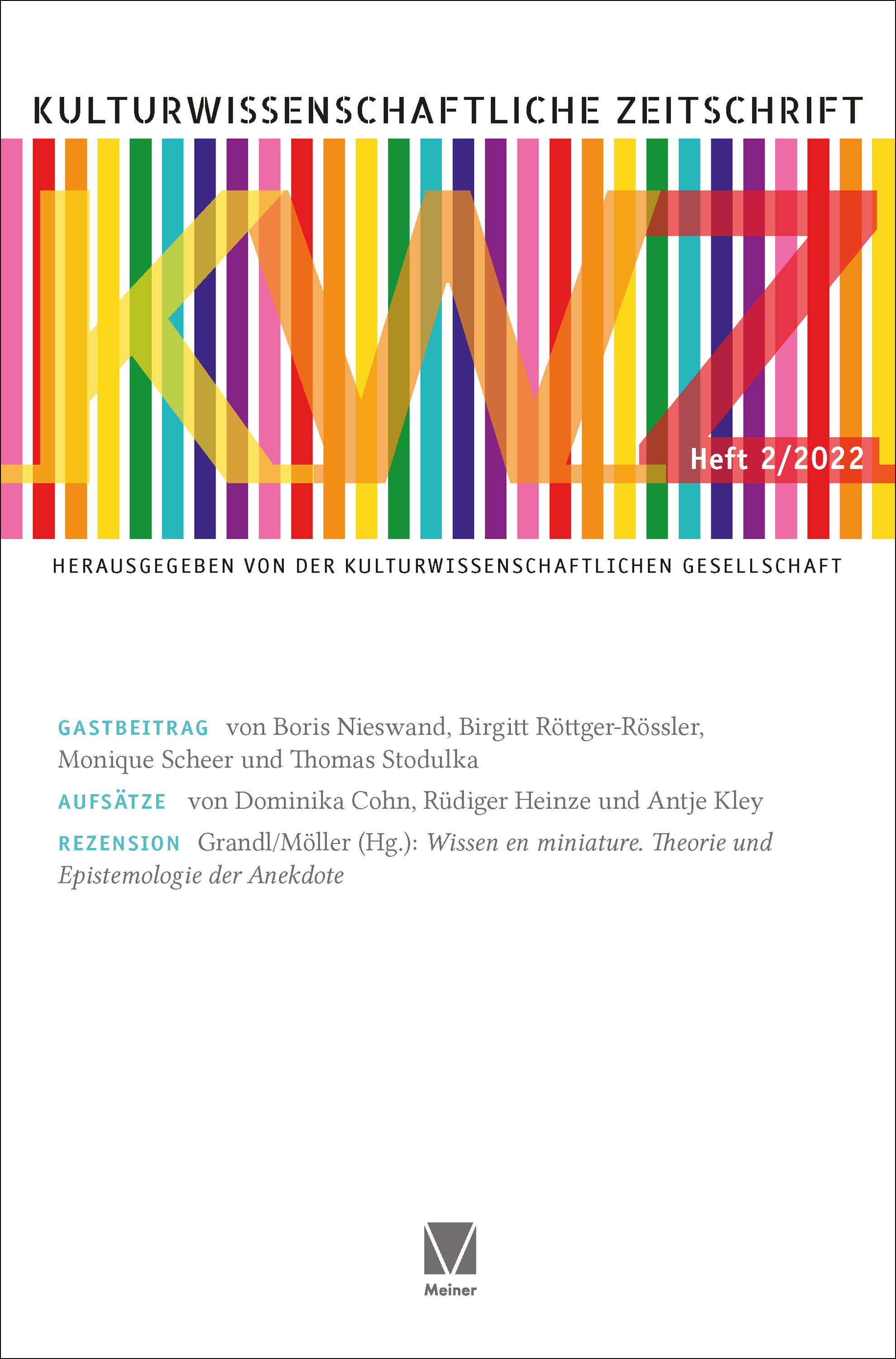- Cover (U1 – 3)
- Inhalt (3 – 5)
- Editorial (5 – 7)
- Birgitt Röttger-Rössler, Boris Nieswand, Monique Scheer, and Thomas Stodulka: Cultural Diversity!? (7 – 23)
- Dominika Cohn: Choreografien des Taktilen (23 – 49)
- 1. Taktile Teilhabe als korporal-sensuelle Partizipation (23 – 30)
- 2. Rezeption von Berührung im partizipativ-choreografischen Rahmen (30 – 35)
- 3. Leiblich-taktile Rezeption als ästhetische Praxis (35 – 42)
- 4. Berühren – eine ästhetische Praxis ohne aktuelle Praxis? (42 – 44)
- 5. Fazit (44 – 49)
Informationen zum Titel

Kulturwissenschaftliche Zeitschrift 2/2022
Erscheinungsjahr: 2022Autor: Kulturwissenschaftliche Gesellschaft
ISBN: 9783787343348
Beschreibung: Die 2016 gegründete Kulturwissenschaftliche Zeitschrift«, herausgegeben von der Kulturwissenschaftlichen Gesellschaft, versteht sich als ein offenes Forum der kulturwissenschaftlichen Debatte, in dem historische wie gegenwartskulturelle Themen, Theorien und Forschungsansätze aus allen Bereichen und Strömungen der Kulturwissenschaften vorgestellt und verhandelt werden.
Abstracts
Editorial.
Röttger-Rössler, Birgitt; Nieswand, Boris; Scheer, Monique; Stodulka, Thomas: Cultural Diversity!? A Roundtable.
In the context of a roundtable held at the international conference ›Diversity Affects – Troubling Institutions‹ organized by the CRC Affective Societies in May 2021 at Freie Universität Berlin four social and cultural scientists critically discussed the meaningfulness of the term ›cultural diversity‹ and debated about the question whether the term ›culture‹ has transfigured into a leftover-category that lumps together the conceptually uncanny, politically uncomfortable, and empirically enigmatic. This article is the edited and revised transcript of this thought-provoking conversation.
Cohn, Dominika: Choreografien des Taktilen. Berühren und Berührtwerden als (absente) ästhetische Praxis
Bis zum Ausbruch der Corona-Pandemie zeichnete sich in den vergangenen Jahren im zeitgenössischen Tanz – wie in den darstellenden und bildenden Künsten insgesamt – ein Trend hin zu partizipativen Arbeiten ab, bei denen das Publikum sich im Rahmen der Aufführung durch den Raum bewegt und physisch mit Performer*innen und Objekten interagiert. Namhafte Choreograf*innen, darunter William Forsythe, Tino Sehgal oder das Kollektiv Ligna, bezogen ihr Publikum in choreografischen Installationen, Audio-Performances oder ›konstruierten Situationen‹ soweit ins Geschehen ein, dass die Teilnehmenden selbst – ihre Handlungen und Bewegungen – zur eigentlichen Choreografie werden. Doch wie lassen sich solche physischen Formen der Publikumspartizipation rezeptionsästhetisch beschreiben? Dieser Frage nähert sich der Beitrag anhand eines wenig bekannten praktischen Beispiels aus dem Bereich der zeitgenössischen Choreografie, der Arbeit CO-TOUCH der drei russischen Künstlerinnen Kristina Petrova, Katia Reshetnikova und Vera Shchelkina. Mit einem Fokus auf sich im Rahmen dieser Arbeit ereignende Berührungen zwischen Teilnehmer*innen und Performer* innen wird zunächst erläutert, warum sich die hier stattfindende taktile Partizipation als eine Form von Rezeption verstehen lässt. In einem zweiten Schritt wird ein Verständnis von Berührungs-Rezeption als ästhetischer Praxis stark gemacht. Abschließend werden die gewonnenen Erkenntnisse vor der Folie der Pandemie-Geschehnisse reflektiert.
Kley, Antje: Vulnerability and Masculinist Notions of Control in Late Capitalist Societies. Reading Paul Kalanithi’s Autopathography When Breath Becomes Air (2016)
This article lays out how Kalanithi’s international bestseller and Pulitzer Prize finalist uses the infrastructures of literature to negotiate the infrastructures and the masculinist values of the medical system. The text chronicles how a promising young male neurosurgeon becomes a terminal patient himself. This radical change of perspective is represented in ambivalent terms of embodiment, vulnerability, and relational being, and as a fall from the masculinist grace of medical discursive power. The text presents the medical hospital as a social space that, in its high-tech efficiency, is ill-equipped for the negotiation of the personally and culturally contradictory process of dying that, in late capitalist societies since the 1980s, predominantly takes place in its confines. With its literary means, the text explores a critical perspective on late capitalist societies’ high-tech medical system that is geared towards the control of disease and cost at the expense of a supportive view of life’s end. With its literary address of a neurosurgeon’s experience of dying, When Breath Becomes Air offers an alternative form of knowledge production to currently dominant medical, care, insurance and legal discourses on death, and it advocates an ease of narrowly masculinist notions of control as key to more resonant social relations.
Heinze, Rüdiger: Cognitive Confusions and Critical Misapprehensions. Henry James’s »The Real Thing«
This essay uses principles and concepts of cognitive psychology and the context of 19th century visual culture to show that the narrator of Henry James’s »The Real Thing« (1892) is an unreliable narrator – a point which has been made before – not primarily because his judgments are incongruous with those of an implied author (a troubled concept in itself) and reader (as has been argued by critics so far) but rather because the manner in which he perceives and judges is so much d’accord with the way humans tend to perceive and judge: by heuristic processes of selection, projection and generalization. AsIwill further argue, theseprocesses of cognitionalso have serious ethical repercussions – a point mostly overlooked so far.
Stricker, Bernhard: Rezension zu: Grandl, Matthias/Möller, Melanie (Hg.) (2021): Wissen en miniature. Theorie und Epistemologie der Anekdote.
Zitierung exportieren


